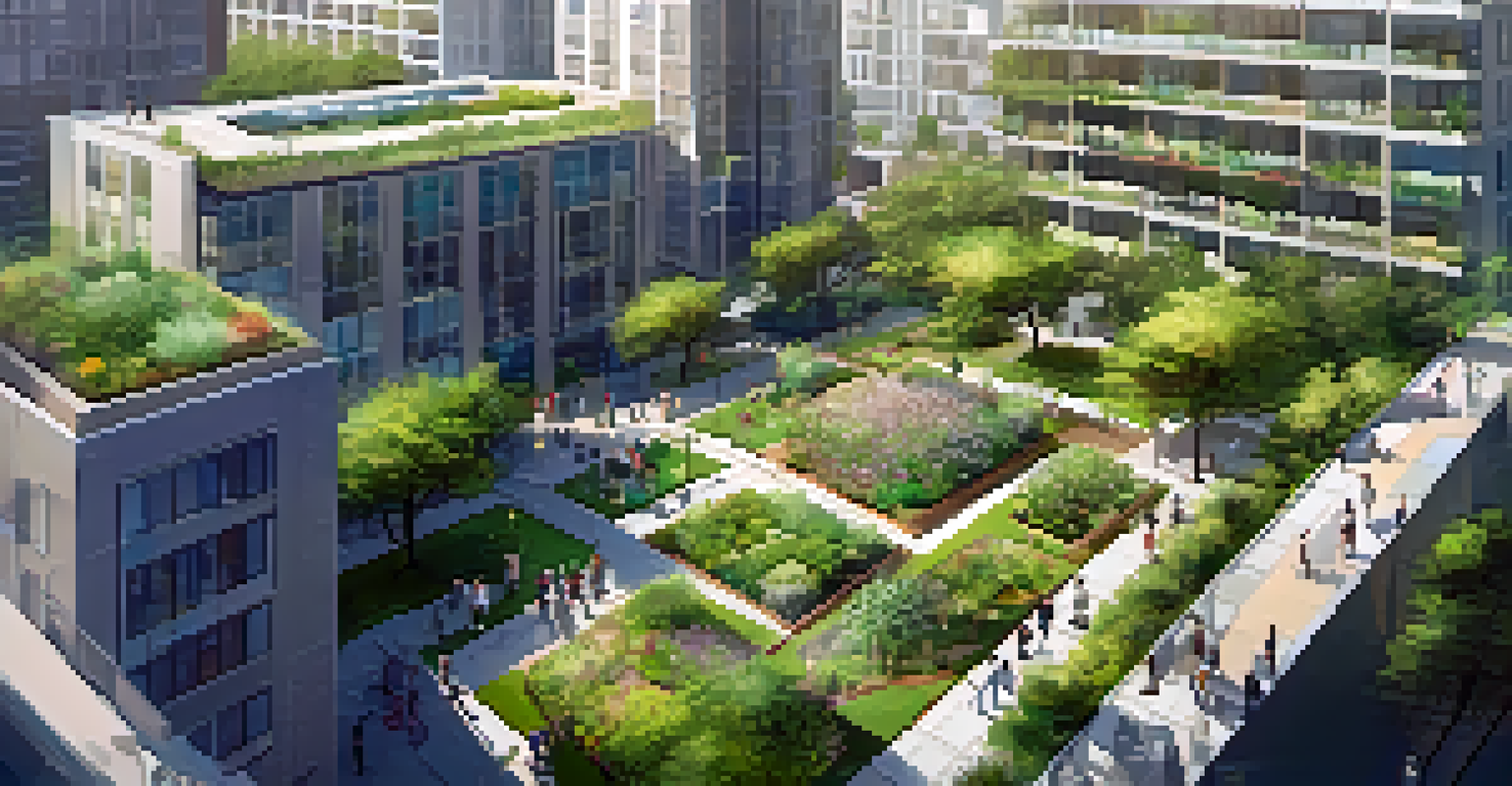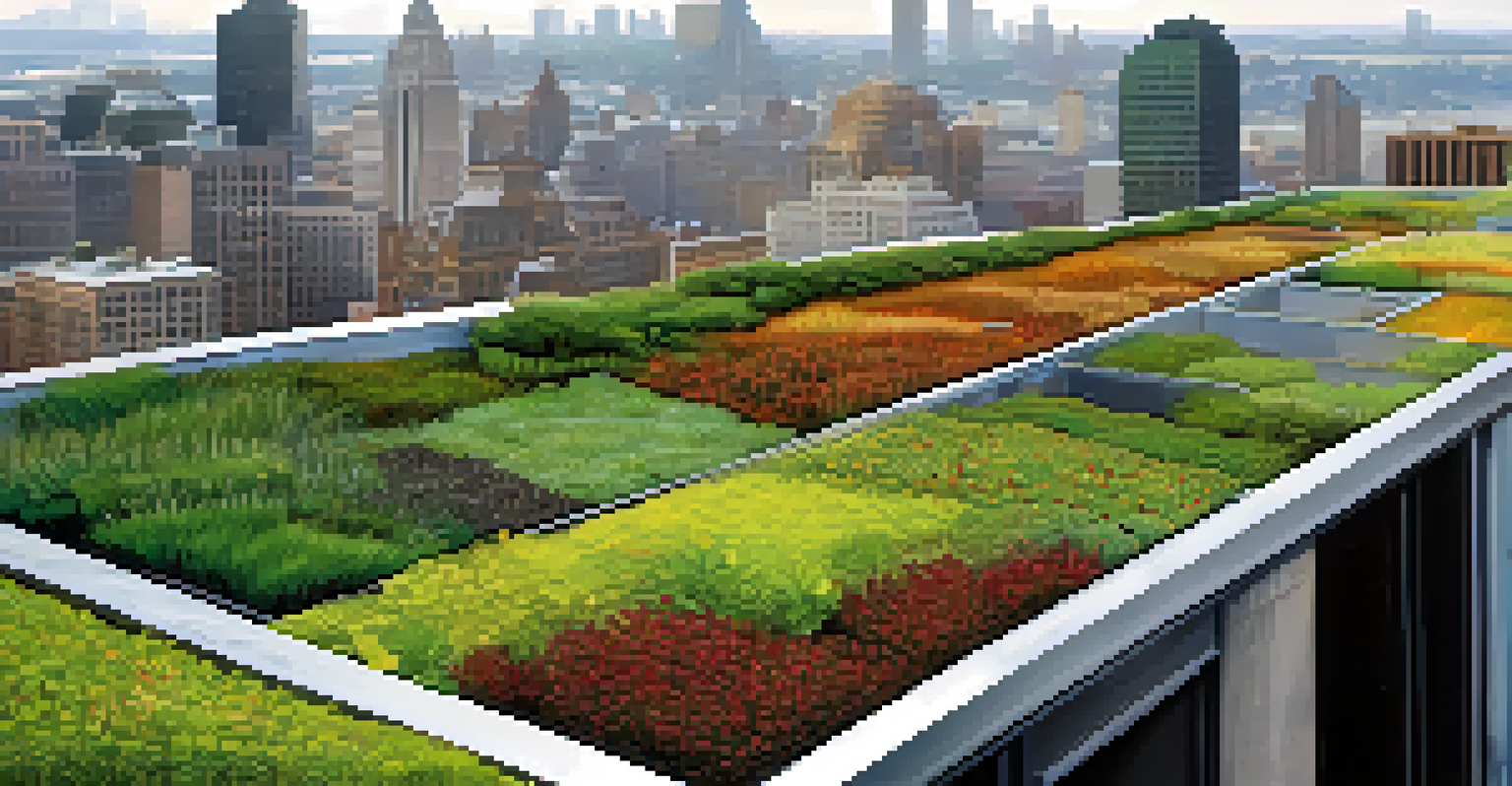Improving Stormwater Management with Green Roofs

Understanding Stormwater Management Challenges
Stormwater management is a significant challenge for urban areas, where impervious surfaces like concrete and asphalt prevent rainwater from soaking into the ground. This leads to increased runoff, which can overwhelm drainage systems and cause flooding. Additionally, pollutants from roads and buildings often wash into waterways, harming aquatic ecosystems.
Green roofs are a great way to manage stormwater and reduce urban heat, while also providing recreational spaces and improving air quality.
The need for effective stormwater management has never been more critical, especially with climate change causing more intense weather events. Cities are facing the dual challenge of managing excess water while also protecting local water quality. Traditional methods, such as expanded drainage systems, can be costly and may not address the root of the problem.
This is where innovative solutions like green roofs come into play, offering a sustainable approach to managing stormwater. By integrating vegetation into building designs, green roofs can reduce runoff, improve air quality, and provide additional green space in urban environments.
What Are Green Roofs and How Do They Work?
Green roofs, also known as living roofs, are essentially gardens that are installed on the rooftops of buildings. They consist of layers that include vegetation, growing medium, and a waterproof membrane. This combination allows rainwater to be absorbed and utilized by the plants, significantly reducing the amount of runoff that reaches the ground.

When it rains, green roofs capture rainfall and hold it in the soil, where plants can absorb it. This process not only minimizes runoff but also helps to filter pollutants, improving the quality of the water that eventually makes its way into drainage systems. Furthermore, the vegetation on green roofs can provide insulation, reducing energy costs for heating and cooling.
Green Roofs Reduce Urban Runoff
Green roofs can absorb up to 80% of rainfall, significantly lowering stormwater runoff and alleviating pressure on drainage systems.
The ability of green roofs to manage stormwater effectively makes them a valuable asset in urban planning. They contribute to a more resilient infrastructure, capable of handling the increased rainfall that climate change brings while enhancing the overall urban landscape.
Benefits of Green Roofs for Stormwater Management
One of the primary benefits of green roofs is their ability to significantly reduce stormwater runoff. Studies have shown that green roofs can absorb up to 80% of rainfall, depending on the design and plant selection. This reduction in runoff helps to alleviate pressure on city drainage systems, reducing the risk of flooding and waterlogging.
The future of our cities depends on integrating nature into urban environments; green roofs are a key component of that vision.
In addition to managing rainwater, green roofs also provide thermal insulation, which helps regulate building temperatures. This energy efficiency can lead to lower utility bills and a smaller carbon footprint. Moreover, they offer a habitat for urban wildlife, contributing to biodiversity in city settings.
The aesthetic appeal of green roofs is another notable advantage. They can transform otherwise unused spaces into vibrant green areas, providing recreational opportunities and improving the mental well-being of residents. This combination of environmental, economic, and social benefits makes green roofs a win-win solution for urban areas.
Designing Effective Green Roofs for Stormwater Control
Design is crucial when it comes to maximizing the stormwater management capabilities of green roofs. Factors such as plant selection, soil depth, and drainage layers all play a role in determining how much water a green roof can retain. Native and drought-resistant plants are often preferred, as they require less maintenance and are better adapted to local conditions.
Incorporating features like retention basins or overflow outlets can further enhance a green roof’s ability to manage stormwater. These elements ensure that excess water is channeled away from the roof and building, preventing potential damage. Proper design also includes consideration for the structural integrity of the building to support the additional weight of a green roof.
Sustainable Design Enhances Functionality
Effective design, including plant selection and drainage features, is crucial for maximizing the stormwater management capabilities of green roofs.
Ultimately, collaborating with landscape architects and engineers during the planning phase can lead to the creation of green roofs that are not only beautiful but also highly functional in stormwater management. This integrated approach ensures that all aspects of the build work together harmoniously.
Case Studies: Successful Green Roof Implementations
Several cities around the world have successfully integrated green roofs into their urban landscapes, showcasing their effectiveness in stormwater management. For instance, Chicago has implemented a variety of green roofs across the city, significantly reducing runoff and improving the urban ecosystem. The city reports that green roofs have contributed to a decrease in combined sewer overflows during heavy rains.
Another great example is the city of Toronto, which has adopted policies promoting green roofs on new commercial buildings. The Toronto Green Roof Bylaw has led to an increase in green roof installations, resulting in improved stormwater management and enhanced biodiversity. These initiatives demonstrate how policy and planning can drive the adoption of green technology.
These case studies highlight the potential benefits of green roofs, not only for stormwater management but also for urban sustainability. They serve as inspiring examples for other cities looking to implement similar strategies to combat the challenges posed by urbanization and climate change.
Challenges and Considerations for Green Roofs
While green roofs offer many benefits, they are not without their challenges. One primary concern is the initial installation cost, which can be higher than traditional roofing options. However, this upfront investment is often offset by long-term savings in energy bills and stormwater management costs, making it a financially viable choice over time.
Maintenance is another important consideration. Green roofs require regular upkeep to ensure the plants thrive and the systems function effectively. This includes watering, weeding, and checking for drainage issues. Building owners must be prepared for this commitment, or consider hiring professional maintenance services.
Challenges of Green Roof Implementation
While green roofs offer numerous benefits, challenges such as initial costs, maintenance, and structural considerations must be addressed.
Lastly, structural considerations must be taken into account when installing a green roof. It's essential to assess whether the existing building can support the additional weight of soil and vegetation. Collaborating with professionals during the design and installation process can help address these challenges effectively.
The Future of Urban Stormwater Management with Green Roofs
As urban areas continue to grow, the need for sustainable stormwater management solutions will only increase. Green roofs are poised to play a critical role in this future, providing an eco-friendly method for managing rainwater while enhancing urban environments. With advancements in technology and design, the potential for green roofs is expanding.
Moreover, as more cities recognize the value of green infrastructure, policies and incentives are likely to emerge, promoting the adoption of green roofs. This could lead to a ripple effect, encouraging more property owners to invest in green roofing solutions. The trend towards greener cities is gaining momentum, and green roofs are at the forefront of this movement.

Ultimately, the integration of green roofs into urban planning can lead to healthier, more resilient cities that are better equipped to handle the challenges of climate change. By embracing green roofs, we can pave the way for a more sustainable future, benefiting both the environment and urban dwellers alike.